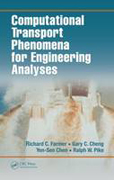
With the dramatic advancement of computer technology, students in chemical engineering must have a firm understanding of complex transport phenomena analysis, which they will certainly encounter as professionals. Bringing together a wealth of professional and instructional experience, this graduate-level curriculum focuses on the current concepts of fluid mechanics, turbulent flow, and multiphase flow, rather than numerics and laminar flow. It stresses a problem-solving approach that incorporates a reliance on the Computational Fluid Dymanics Code (CFD). The text presents one code at a time so that students are better able to understand the strengths and limitations of the technique, which they will use frequently in their profession. INDICE: Computational Transport Phenomena Overview Transport Phenomena Analyzing Transport Phenomena A Computational Tool: The CTP Code Verification, Validation, and Generalization Summary Nomenclature References The Equations of Change Introduction Derivation of The Continuity Equation Derivation of The Species Continuity Equation Derivation of The Equation Of Motion Derivation of The General Energy Equation Non-Newtonian Fluids General Property Balance Analytical and Approximate Solutions for the Equations of Change Summary Nomenclature References Physical Properties Overview Real-Fluid Thermodynamics Chemical Equilibrium and Reaction Kinetics Molecular Transport Properties Thermal Radiation Properties Nomenclature References Turbulence Modeling Concepts Reynolds Averaging and Eddy Viscosity Models Turbulence Characteristics Reynolds and Favre Averaging Eddy Viscosity Models Nomenclature Appendix 4.A: Basic Probability Parameters References Other Turbulence Models More Comprehensive TurbulenceModels Differential Second-Moment Closure Methods Probability Density Function Models Direct Numerical Simulation Large Eddy Simulation Laminar-To-Turbulent Transition Models Nomenclature References Computational Coordinates and Conservation Laws Overview Coordinates Conservation Laws in Computational Coordinates Transformed CTP Equations Nomenclature Appendix 6.A Transformed Terms Which Complete the System of Conservation Laws References Numerical Methods for Solving Governing Equations Overview Density-Based and Pressure-Based Methods Numerical Methods Grid Topologies Space--Time Conservation-Element/Solution-Element Methods Nomenclature References The CTP Code Grids Discretized Conservation Equations Upwind and Dissipation Schemes Solution Strategy Time-Marching Scheme Boundary Conditions Initial Conditions Ctp Code Features User's Guide Nomenclature Multiphase Phenomena Scope Dilute Suspensions Interphase Mass Transfer Multiphase Effects Included in the CTP Code Population Balance Models Dense Particulate Flows Nomenclature References Closure References APPENDIX A A
- ISBN: 978-1-4200-6756-9
- Editorial: CRC Press
- Encuadernacion: Cartoné
- Páginas: 530
- Fecha Publicación: 01/06/2009
- Nº Volúmenes: 1
- Idioma: Inglés
